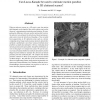Free Online Productivity Tools
i2Speak
i2Symbol
i2OCR
iTex2Img
iWeb2Print
iWeb2Shot
i2Type
iPdf2Split
iPdf2Merge
i2Bopomofo
i2Arabic
i2Style
i2Image
i2PDF
iLatex2Rtf
Sci2ools
112
Voted
CRV
2007
IEEE
2007
IEEE
Can Lucas-Kanade be used to estimate motion parallax in 3D cluttered scenes?
When an observer moves in a 3D static scene, the motion field depends on the depth of the visible objects and on the observer’s instantaneous translation and rotation. By computing the difference between nearby motion field vectors, the observer can estimate the direction of local motion parallax and in turn the direction of heading. It has recently been argued that, in 3D cluttered scenes such as a forest, computing local image motion using classical optical flow methods is problematic since these classical methods have problems at depth discontinuities. Hence, estimating local motion parallax from optical flow should be problematic as well. In this paper we evaluate this claim. We use the classical Lucas-Kanade method to estimate optical flow and the Rieger-Lawton method to estimate the direction of motion parallax from the estimated flow. We compare the motion parallax estimates to those of the frequency based method of Mann-Langer. We find that if the Lucas-Kanade estimat...
Related Content
| Added | 02 Jun 2010 |
| Updated | 02 Jun 2010 |
| Type | Conference |
| Year | 2007 |
| Where | CRV |
| Authors | Vincent Chapdelaine-Couture, Michael S. Langer |
Comments (0)

